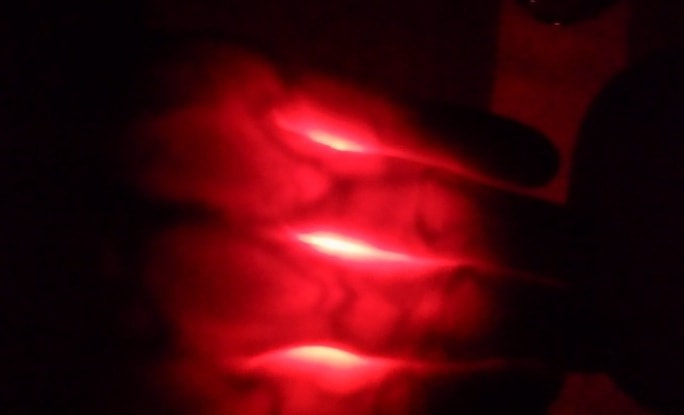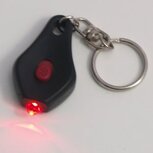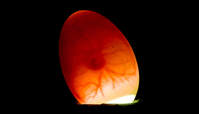Click and expand the tabs below to get started. what you'll need
experimental procedure
what's happening
The light from your flashlight may appear white, but it is actually many different colors of light all mixed together, which your brain simply interprets as white. It's kind of amazing, but all of those individual colors just sort of disappear (at least as far as your brain is concerned), but they are all still there. When you shine this light into your hand most of the colors are either blocked or absorbed by your body, but the red light rays pass right through, which is why your hand appears to glow red (which, by the way, proves that there really was red light in your "white" flashlight to begin with). However, there is one part of your body where even these red light rays can't penetrate, and that is the blood in your veins. Since only veins absorb the red light they appear as dark lines inside your glowing red hand. Are you surprised that you can see your veins but you can't see your bones? It doesn't matter that bones are thick and hard, red light rays still pass right through them as if they aren't even there!
more detailed explanation
First a little background science. Light appears in many colors because each color has a different wavelength. We call this the visible spectrum, and a rainbow's colors show us the full spectrum of visible wavelengths or colors, from red which has the longest wavelengths (and therefore the least energy) through orange, yellow and green in the middle wavelengths to blue and violet which has the shortest wavelength (and the most energy), and least for the light rays that we can see. What we call "white" light is actually what we see when all (or at least most) of these wavelengths are combined together at the same time, but these individual colors can be separated in several ways. One way is to use a specially shaped piece of glass or plastic called a prism (see the PBS video link below), but actually the color of just about any object you see (like a red T-shirt, green grass, or a blue bicycle) is usually due to separating colors of light. When light from the sun, a lamp, or in this experiment your flashlight hits an object, any (or all) of three things can happen: some of the light- and more importantly, particular wavelengths- may bounce off the object (reflection); some may pass through the object (transmission); and some can be absorbed by the object (kind of like a sponge absorbs water). Normally we see most objects because of the reflected light that bounces off and into our eyes, so it's natural to assume that all light always bounces of objects, but in fact grass appears green because it absorbs most of the light which hits it. Only the green wavelengths of light bounce off and into our eyes. Most of the red, blue and other colors are actually absorbed by the grass. They literally disappear and never reach our eyes. By the way, the energy from this light which the grass absorbs is what the plant uses for photosynthesis. Glass, on the other hand, is usually transparent, which means that most of the light passes through it without any absorption. Imagine that you are standing inside a dark church admiring the beautiful colors of a stained-glass window as the sunlight outside the church passes through each of the colored panels. One panel looks red because mostly red wavelengths pass through the glass and into your eyes. The other wavelengths are either reflected at the surface or are absorbed by the glass. The same is true for any green or blue panels- only green or blue light passes through the glass. The other colors we see, like yellow, are due to mixing these three primary colors. [Color mixing is a fascinating subject, but we'll leave that for another experiment. If you're interested, check out the links below.] Now we're ready to talk about what's happening in your hand. Just as with stained glass, the various cells in your body (skin, muscle, bone, blood, etc.) can either reflect, absorb or pass (transmit) the various wavelengths or colors of visible light. As you might expect, most of the light (of all colors) bounces off your outer skin, but if you hold the flashlight very close, some of it will penetrate. Of the light which penetrates, most is quickly absorbed by various cells in your body, but a little bit of it can pass completely through some thinner parts of your body. That's why we need to do this experiment in a very dark room, and use a thin part of your body, like your hand or fingers. What's really cool is that red is the only color of light passes completely through your hand. That's why it appears red. All of the other colors are completely absorbed, either by the skin, bones, muscles, blood or other cells in your body. Most of the red light passes right through all of these cells except for blood cells- but not all blood cells. Red light passes through the blood in your arteries, but is absorbed by the blood in your veins. That's why your veins appear dark. Did you notice that red light even passes right through your bones? It's as though your skeleton has vanished! What's the difference between the blood in your arteries and veins? The answer is oxygen. Arteries carry freshly oxygenated red blood cells away from your lungs to replenish the other cells in your body. Once these red cells have given up most of their oxygen they return to your lungs in the veins to get more and start the process over again. When blood is fully oxygenated it's a very bright red color, but without oxygen it appears a much darker maroon color, and this darker blood in your veins easily absorbs most red light, thus no light passes through (i.e. absorption = dark). By the way, it's a well established myth that the blood in your veins is blue because it has lost its oxygen. While the veins which you can see near the surface of your skin do often appear to be blue, it is not because the blood inside them is blue. Human blood is never blue, although horseshoe crabs and some other animals do in fact have blue blood (see the reference links below). The actual reason that your veins appear blue is rather complicated, but it also has to do with absorption, transmission and reflection of different wavelengths of light (see links below for a more detailed explanation). A white flashlight works in this experiment because white light really contains all of the colors, including some red. It works even better if you use a red flashlight, since all of this light is red, and you will notice how much brighter your hand appears. If you use any other color flashlight, however, you won't see any light pass through your hand. Try it. variations and related activities
If you have a remote control for your television with buttons that light up when you press them you may have noticed that when you press a button (in the dark) that lights up red, it makes your fingertip glow bright red. However, if the button lights up green or blue, your finger doesn't glow at all. Now you know why.
references and links to more information
Bill Nye the Science Guy episode on light & color: Another PBS video on light & color: How is light absorbed, reflected or transmitted by different materials:
More about blood, arteries and veins:
Why do veins look blue if your blood is really red?:
Horseshoe Crabs do have blue blood: Egg candling:
A good place to buy cheap LED flashlights in different colors:
Return to Try Science at Home
0 Comments
|









